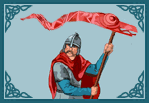 |
 |
|||
|
|
The 'Life of St. Kentigern' tells us that Constantine was the only son of King Riderch Hael of Strathclyde and his wife, Queen Languoreth. Born perhaps in the 570s, he was said to have been converted to Christianity early in his life, possibly by SS. Columba or Kentigern himself, as recorded in the Annals of Ulster for AD 589. He would have succeeded to his father's throne in AD 612 but probably did not rule for long. Despite this, it was recorded that he "overcame all the barbarous nations in his vicinity without bloodshed, surpassing all the kings that had reigned before him in Cambria, in riches, glory and dignity ... and holiness ... so that to the present day he is called St. Constantine by many". According to the 'Life of St. Ninnoc', Constantine was married and had at least one daughter, Menedoc, who married a certain Prince Brychan, probably a sub-King of Manau-Gododdin rather than the more famous King of Brycheiniog. Eventually, it seems that Constantine resigned his throne in favour of his grandfather's cousin, Neithon ap Guidno. He entered a religious life, probably in Ireland, where an old story tells that he lived as an anonimous lay brother, hand-grinding corn for the monks with a quern-stone. One day, one of his brethren heard him chuckling to himself, "Can this be King Constantine, who wore helm and bore shield, drudging at a handmill?". His identity discovered, he was encouraged to become a student and thence a priest. He succeeded St. Mo-Chuda as Abbot of Rahan, in Offaly, around AD 636. Later, Constantine probably returned to Scotland, founded churches at Kirkconstantine, Kenneil and Dunnechtyn and the famous monastery at Govan, on the Clyde. There he died and was buried, and his supposed shrine can still be seen today in the parish church. His feast day is 11th March. Records of King Constantine date back to the 12th century. He is generally considered legendary.
|
|||
| © Nash Ford Publishing 2001. All Rights Reserved. | ||||




